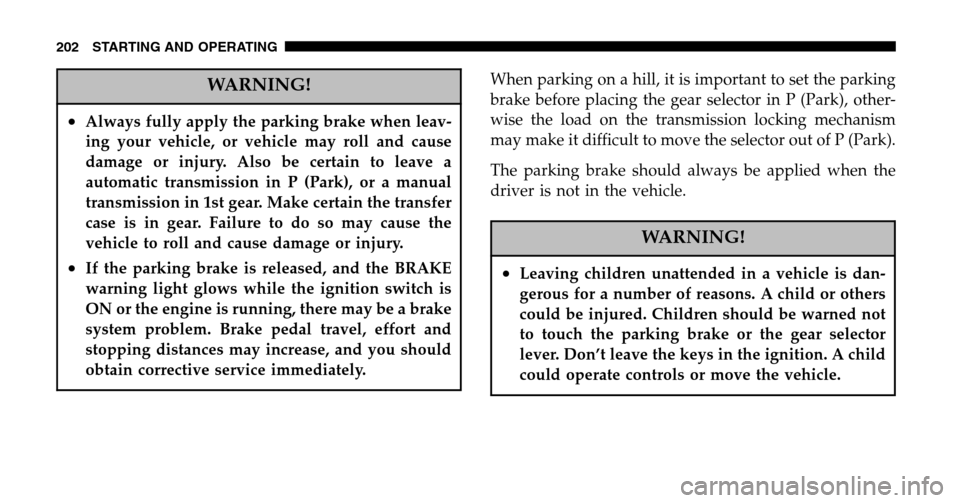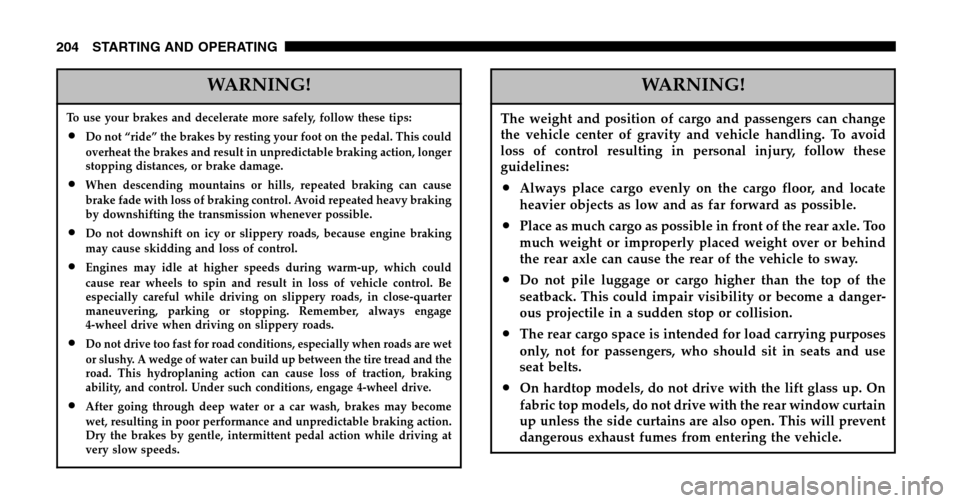engine JEEP WRANGLER 2006 TJ / 2.G Owner's Guide
[x] Cancel search | Manufacturer: JEEP, Model Year: 2006, Model line: WRANGLER, Model: JEEP WRANGLER 2006 TJ / 2.GPages: 368, PDF Size: 14.3 MB
Page 195 of 368

Operating Instructions/Precautions
The transfer case provides four mode positions — two
(rear) wheel drive high range, four wheel drive high
range, neutral, and four wheel drive low range.
This transfer case is intended to be driven in the two
wheel drive (2H) position for normal street and highway
conditions such as dry hard surfaced roads.
In the events when additional traction is required, the
transfer case 4H and 4L positions can be used to lock the
front and rear driveshafts together and force the front
and rear wheels to rotate at the same speed. This is
accomplished by simply moving the shift lever to these
positions. The 4H and 4L positions are intended for loose,
slippery road surfaces only. Driving in the 4H and 4L
positions on dry hard surfaced roads may cause in-
creased tire wear and damage to the driveline compo-
nents. The 4WD indicator light, located in the instrument panel,
alerts the driver that the vehicle is in four wheel drive
and that the front and rear driveshafts are locked to-
gether. This light illuminates when the transfer case is
shifted to either the 4H or 4L positions.
NOTE:
Do not attempt to make a shift while only the
front or rear wheels are spinning. The transfer case is not
equipped with a synchronizer and therefore the front and
rear driveshafts speeds must be equal for the shift to take
place. Shifting while only the front or rear wheels are
spinning can cause damage to the transfer case.
When operating your vehicle in 4L, the engine speed is
approximately three times that of the 2H or 4H positions
at a given road speed. Take care not to overspeed the
engine and do not exceed 25 mph (40 km/h).
STARTING AND OPERATING 195
5
Page 198 of 368

is coasting at 2 to 3 mph (3 to 5 km/h), shift the transfer
case lever firmly to the desired position. Do not pause in
transfer case N (Neutral).
NOTE: Pausing in transfer case N (Neutral) in vehicles
equipped with an automatic transmission may require
shutting the engine OFF to avoid gear clash while
completing the shift. If difficulty occurs, shift the auto-
matic transmission to N (Neutral), hold foot on brake,
and turn the engine OFF. Make shift to desired mode.
NOTE: Shifting into or out of 4L is possible with the
vehicle completely stopped, however, difficulty may oc-
cur due to the mating teeth not being properly aligned.
Several attempts may be required for clutch teeth align-
ment and shift completion to occur. The preferred
method is with the vehicle rolling at 2 to 3 mph (3 to 5
km/h). Avoid attempting to engage or disengage 4L with
the vehicle moving faster than 2 to 3 mph (3 to 5 km/h).WARNING!
Failure to engage a position completely can cause
transfer case damage or loss of power and vehicle
control. You could have an injury accident. Do not
drive the vehicle unless the transfer case is fully
engaged.
TRAC-LOK™ REAR AXLE
The Trac-Lok™ rear axle provides a constant driving
force to both rear wheels and reduces wheel spin caused
by the loss of traction at one driving wheel. If traction
differs between the two rear wheels, the differential
automatically proportions the usable torque by providing
more torque to the wheel that has traction.
Trac-Lok™ is especially helpful during slippery driving
conditions. With both rear wheels on a slippery surface, a
198 STARTING AND OPERATING
Page 199 of 368

slight application of the accelerator will supply maxi-
mum traction. When starting with only one rear wheel on
an excessively slippery surface, slight application of the
parking brake may be necessary to gain maximum trac-
tion.
WARNING!
On vehicles equipped with a limited-slip differen-
tial, never run the engine with one rear wheel off the
ground. The vehicle may drive through the rear
wheel remaining on the ground and cause you to
lose control of your vehicle.
AXLE LOCK (TRU–LOK™) — IF EQUIPPED
The Axle Lock switch is located on the lower center of the
instrument panel.
This feature will only activate when the following con-
ditions are met:
•Key in ignition, vehicle in 4L (Low) range.
Axle Lock Switch
STARTING AND OPERATING 199
5
Page 202 of 368

WARNING!
•Always fully apply the parking brake when leav-
ing your vehicle, or vehicle may roll and cause
damage or injury. Also be certain to leave a
automatic transmission in P (Park), or a manual
transmission in 1st gear. Make certain the transfer
case is in gear. Failure to do so may cause the
vehicle to roll and cause damage or injury.
•If the parking brake is released, and the BRAKE
warning light glows while the ignition switch is
ON or the engine is running, there may be a brake
system problem. Brake pedal travel, effort and
stopping distances may increase, and you should
obtain corrective service immediately.
When parking on a hill, it is important to set the parking
brake before placing the gear selector in P (Park), other-
wise the load on the transmission locking mechanism
may make it difficult to move the selector out of P (Park).
The parking brake should always be applied when the
driver is not in the vehicle.
WARNING!
•Leaving children unattended in a vehicle is dan-
gerous for a number of reasons. A child or others
could be injured. Children should be warned not
to touch the parking brake or the gear selector
lever. Don’t leave the keys in the ignition. A child
could operate controls or move the vehicle.
202 STARTING AND OPERATING
Page 203 of 368

ABOUT YOUR BRAKES
Your vehicle is equipped with power assisted brakes as
standard equipment. In the event power assist is lost for
any reason (for example, repeated brake applications
with the engine off), the brakes will still function. The
effort required to brake the vehicle will be much greater
than that required with the power system operating.
WARNING!
Riding the brakes can lead to brake failure and
possibly an accident. Driving with your foot resting
or riding on the brake pedal can result in abnormally
high brake temperatures, excessive lining wear, and
possible brake damage. You wouldn’t have your full
braking capacity in an emergency.
If either of two hydraulic systems lose normal capability,
the remaining system will still function with some loss of
overall braking effectiveness. This will be evident by
increased pedal travel during application and greater
pedal force required to slow or stop.
STARTING AND OPERATING 203
5
Page 204 of 368

WARNING!
To use your brakes and decelerate more safely, follow these tips:
•Do not “ride” the brakes by resting your foot on the pedal. This could
overheat the brakes and result in unpredictable braking action, longer
stopping distances, or brake damage.
•When descending mountains or hills, repeated braking can cause
brake fade with loss of braking control. Avoid repeated heavy braking
by downshifting the transmission whenever possible.
•Do not downshift on icy or slippery roads, because engine braking
may cause skidding and loss of control.
•Engines may idle at higher speeds during warm-up, which could
cause rear wheels to spin and result in loss of vehicle control. Be
especially careful while driving on slippery roads, in close-quarter
maneuvering, parking or stopping. Remember, always engage
4-wheel drive when driving on slippery roads.
•Do not drive too fast for road conditions, especially when roads are wet
or slushy. A wedge of water can build up between the tire tread and the
road. This hydroplaning action can cause loss of traction, braking
ability, and control. Under such conditions, engage 4-wheel drive.
•After going through deep water or a car wash, brakes may become
wet, resulting in poor performance and unpredictable braking action.
Dry the brakes by gentle, intermittent pedal action while driving at
very slow speeds.
WARNING!
The weight and position of cargo and passengers can change
the vehicle center of gravity and vehicle handling. To avoid
loss of control resulting in personal injury, follow these
guidelines:
•Always place cargo evenly on the cargo floor, and locate
heavier objects as low and as far forward as possible.
•Place as much cargo as possible in front of the rear axle. Too
much weight or improperly placed weight over or behind
the rear axle can cause the rear of the vehicle to sway.
•Do not pile luggage or cargo higher than the top of the
seatback. This could impair visibility or become a danger-
ous projectile in a sudden stop or collision.
•The rear cargo space is intended for load carrying purposes
only, not for passengers, who should sit in seats and use
seat belts.
•On hardtop models, do not drive with the lift glass up. On
fabric top models, do not drive with the rear window curtain
up unless the side curtains are also open. This will prevent
dangerous exhaust fumes from entering the vehicle.
204 STARTING AND OPERATING
Page 205 of 368

WARNING!
To help avoid personal injury, follow these tips:
•Never reach through the steering wheel to operate
steering column controls. Injury to your hands or
loss of vehicle control may result.
•If the engine stalls or power assist fails due to a
malfunction, vehicle steering and braking will
require greater effort.
ANTI-LOCK BRAKE SYSTEM — IF EQUIPPED
The Anti-Lock Brake System is designed to aid the driver
in maintaining vehicle control under adverse braking
conditions. The system operates with a separate com-
puter to modulate hydraulic pressure to prevent wheel
lock-up and help avoid skidding on slippery surfaces. All vehicle wheels and tires must be the same size and
type and tires must be properly inflated to produce
accurate signals for the computer.
WARNING!
Significant over or under-inflation of tires, or mixing
sizes of tires or wheels on the vehicle can lead to loss
of braking effectiveness.
The Anti-Lock Brake System conducts a low speed self-
test at about 12 mph (20 km/h). If for any reason, your
foot is on the brake when the vehicle reaches 12 mph (20
km/h), this check will be delayed until 25 mph (40
km/h).
STARTING AND OPERATING 205
5
Page 210 of 368

and/or the flow rate is reduced. If you must cross
flowing water avoid depths in excess of 9 inches. The
flowing water can erode the streambed causing your
vehicle to sink into deeper water. Determine exit point(s)
that are downstream of your entry point to allow for
drifting.
Standing Water
Avoid driving in standing water deeper than 20 inches,
and reduce speed appropriately to minimize wave ef-
fects. Maximum speed in 20 inches of water is less than 5
mph (8 km/h).
Maintenance
After driving through deep water, inspect your vehicle
fluids and lubricants (engine oil, transmission oil, axle,
transfer case) to assure the fluids have not been contami-
nated. Contaminated fluid (milky, foamy in appearance)
should be flushed/changed as soon as possible to pre-
vent component damage.Driving In Snow, Mud and Sand
In heavy snow, when pulling a load, or for additional
control at slower speeds, shift the transmission to a low
gear and shift the transfer case to 4L (Low) if necessary.
Refer to “Four-Wheel Drive Operation” in this section.
Do not shift to a lower gear than necessary to maintain
headway. Over-revving the engine can spin the wheels
and traction will be lost.
Avoid abrupt downshifts on icy or slippery roads, be-
cause engine braking may cause skidding and loss of
control.
Hill Climbing
NOTE: Before attempting to climb a hill, determine the
conditions at the crest and/or on the other side.
Before climbing a steep hill, shift the transmission to a
lower gear and shift the transfer case to 4L (Low). Use
first gear and 4L (Low) for very steep hills.
210 STARTING AND OPERATING
Page 211 of 368

If you stall or begin to lose headwaywhile climbing a
steep hill, allow your vehicle to come to a stop and
immediately apply the brakes. Restart the engine and
shift to R (Reverse). Back slowly down the hill allowing
the compression braking of the engine to help regulate
your speed. If the brakes are required to control vehicle
speed, apply them lightly and avoid locking or skidding
the tires.
WARNING!
If the engine stalls or you lose headway or cannot
make it to the top of a steep hill or grade, never
attempt to turn around. To do so may result in
tipping and rolling the vehicle. Always back care-
fully straight down a hill in R (Reverse) gear. Never
back down a hill in N (Neutral) using only the brake.
Remember, never drive diagonally across a hill-always
drive straight up or down.
If the wheels start to slip as you approach the crest of a
hill, ease off the accelerator and maintain headway by
turning the front wheels slowly left and right. This may
provide a fresh “bite” into the surface and will usually
provide traction to complete the climb.
Traction Downhill
Shift the transmission into a low gear and the transfer
case to 4L (Low) range. Let the vehicle go slowly down
the hill with all four wheels turning against engine
compression drag. This will permit you to control the
vehicle speed and direction.
When descending mountains or hills, repeated braking
can cause brake fade with loss of braking control. Avoid
repeated heavy braking by downshifting the transmis-
sion whenever possible.
STARTING AND OPERATING 211
5
Page 229 of 368

These effects can be reduced by timely rotation of tires.
The benefits of rotation are especially worthwhile with
aggressive tread designs such as those on On/Off Road
type tires. Rotation will increase tread life, help to main-
tain mud, snow, and wet traction levels, and contribute to
a smooth, quiet ride.
Follow the recommended tire rotation frequency for your
type of driving found in the “Maintenance Schedules”
Section of this manual. More frequent rotation is permis-
sible if desired. The reasons for any rapid or unusual
wear should be corrected prior to rotation being per-
formed.
The suggested rotation method is the “forward-cross”
shown in the following diagram.
FUEL REQUIREMENTS
Your engine is designed to meet all emis-
sions regulations and provide excellent
fuel economy and performance when us-
ing high quality unleaded gasoline having
an octane rating of 87. The use of premium
gasoline is not recommended. The use of
STARTING AND OPERATING 229
5